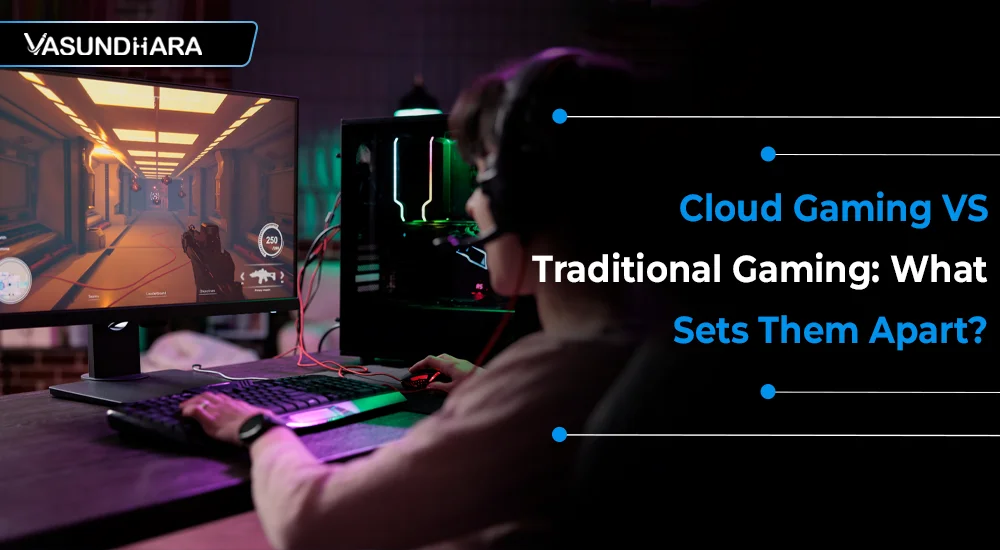Cloud Gaming VS Traditional Gaming: What Sets Them Apart?


- Oct 15, 2024



In recent years, cloud gaming has revolutionized how we engage with video games. This innovative approach allows players to enjoy their favorite titles anytime and anywhere, eliminating the need for bulky hardware and high-end consoles. With cloud gaming, you can access a vast library of games directly through the internet, making it easier than ever to dive into your next gaming adventure, whether at home or on the go.
On the other hand, traditional gaming maintains its charm and appeal, reminiscent of the days when you would gather around the living room with friends or family, console in hand. With traditional gaming, you pop a disc into your console or boot up your computer, and you’re instantly transported into captivating worlds, embarking on epic quests and heroic journeys. This hands-on experience places you at the center of your gaming narrative, allowing for a deeper connection with the characters and stories you encounter.
In this article, we’ll examine the pros and cons of traditional gaming VS cloud gaming. By exploring their fundamental differences, we aim to help you determine which gaming model is best suited to enhance your overall gaming experience. Whether you’re a die-hard console enthusiast or curious about the benefits of cloud gaming, there’s something here for everyone!
Cloud gaming, also known as game streaming, is a revolutionary approach to playing video games that leverages cloud computing technology. while traditional gaming, which relies on powerful consoles or PCs to run games locally, cloud gaming allows players to stream games directly from remote servers over the internet. This means you can enjoy high-quality gaming experiences without the need for expensive hardware or long installation times.
In a cloud gaming setup, the game runs on a powerful server located in a data center, rather than on the player's local device. When you initiate a game, the server processes the gameplay and renders the graphics in real-time. The visual output is then streamed to your device as a video feed, while your inputs are sent back to the server almost without delay. This two-way communication allows you to experience the game as if it were running locally, even though it is hosted remotely.
Read More: The Power of 2D and 3D Game Animation in Today's Gaming World
Cloud gaming has emerged as a leading-edge innovation in the gaming industry, transforming how players access and enjoy their favorite titles. Let’s explore the pros and cons of cloud gaming to understand its impact on the gaming experience better.
| Pros | Cons |
| Cloud gaming allows players to access games on various devices, including smartphones, tablets, and low-spec PCs, without the need for high-end hardware. | A stable, high-speed internet connection is essential for a smooth gaming experience, which can be a barrier for those in areas with poor connectivity. |
| Users can start playing games almost immediately without waiting for downloads or updates, streamlining the gaming experience. | Input lag can occur due to streaming, affecting fast-paced games where timing is crucial, potentially diminishing the overall experience. |
| Subscription models often provide access to a wide library of games for a single monthly fee, making it financially appealing for gamers who want to try multiple titles. | Streaming games can consume significant amounts of data, which might be a concern for users with limited bandwidth or data caps. |
| Many cloud gaming services support cross-platform play, enabling users to play with friends regardless of their devices. | Players may not truly "own" their games, as access can be revoked if the service changes or shuts down, leading to concerns about game preservation. |
| Games are updated automatically on the server side, ensuring players always have access to the latest versions without manual intervention. | With multiple cloud gaming services available, users may feel overwhelmed by subscription costs and choices, leading to potential burnout. |
Traditional gaming represents the classic approach that has defined the industry for years. With dedicated hardware like consoles and PCs, players have the opportunity to own physical copies of games, create personal collections, and experience high-quality graphics and performance.
For many, traditional gaming is more than just a hobby; it’s a passion that fosters community, creativity, and social interaction. Whether gathered in a living room for a multiplayer session or competing in online tournaments, traditional gaming has a unique way of bringing people together, creating lasting memories and friendships along the way.
Traditional gaming, with its roots firmly planted in physical consoles and PCs, has been the cornerstone of the gaming community for decades. In this discussion, we’ll explore the pros and cons of traditional gaming, highlighting its enduring appeal and the hurdles it must navigate in a changing world.
| Pros | Cons |
| Players purchase physical or digital copies of games, giving them permanent access without the risk of losing titles if a service shuts down. | High-performance gaming often requires significant investment in hardware, which can be a barrier for some players. |
| Games run directly on local hardware, often resulting in better graphics, faster load times, and reduced input lag compared to cloud gaming. | Input lag can occur due to streaming, affecting fast-paced games where timing is crucial, potentially diminishing the overall experience. |
| Many traditional games can be played without an internet connection, making them accessible in various environments, including those with poor connectivity. | Traditional gaming is often tied to specific consoles or PCs, limiting play options on other devices. |
| Many traditional games support mods, allowing players to customize and enhance their gaming experience, fostering creativity and community engagement. | Physical copies of games require storage space, and managing a large collection can become cumbersome. |
| Physical copies of games can be collectible items, appealing to gamers who enjoy building a library and appreciating game art and packaging. | Players must periodically upgrade their hardware to keep up with the latest games, which can be expensive and time-consuming. |
The landscape of gaming has evolved significantly with the introduction of cloud gaming, leading to various differences when compared to traditional gaming. Here are some key distinctions:
Games are hosted on powerful remote servers in data centers. Players access these games via streaming technology, which sends audio and video to the player’s device while receiving input commands back. This means that players can enjoy high-quality graphics and gameplay without needing the latest hardware.
Games are stored and processed locally on gaming consoles (like PlayStation and Xbox), PCs, or handheld devices. Players must install games from physical media (discs) or digital downloads before playing.
Because the processing happens on remote servers, players can use a wide range of devices with varying specifications. This democratizes access to gaming, as even older or lower-end devices can run graphically demanding games.
Requires specific hardware capabilities. For example, many modern games need powerful GPUs and CPUs, which can be costly. Users may have to upgrade their systems frequently to keep up with new game requirements.
Players can access a wide range of games instantly. There’s no need to wait for downloads or installations, making it easy to try new titles. Some services offer a subscription model, giving players access to a library of games for a monthly fee.
Players must acquire each game separately, which can take time and effort. There may also be wait times for downloads, especially for larger titles, leading to a less immediate gaming experience.
Performance is highly dependent on internet speed and latency. High latency can lead to noticeable input lag, which can be detrimental in fast-paced games. Players in remote locations or those with slow connections may experience degraded performance.
Generally offers superior performance with lower latency, providing a smoother experience. Local processing means players have better control over frame rates and graphics settings.
Updates and patches can be applied server-side, meaning players always access the latest version of a game. This can enhance the user experience by removing the burden of manual updates.
Players often need to download updates manually, which can be cumbersome and require significant storage space. This can delay playtime as users wait for downloads to complete.
While many best cloud gaming services incorporate social features, the multiplayer experience can be affected by latency issues, leading to lag during competitive play. However, these services can foster communities by connecting players across platforms.
Often provides a more stable and reliable multiplayer experience due to lower latency. Local multiplayer gaming can enhance social interactions, making it easy to play with friends in the same room.
Subscription services often provide access to a wide variety of games at a relatively low monthly cost. This model can be more affordable for players who want to explore multiple games without a hefty investment upfront.
Players usually purchase games individually, which can become expensive over time, especially for high-profile titles. However, once a game is purchased, there are no recurring fees associated with its access.
A stable and fast internet connection is crucial for a good gaming experience. Without it, gameplay can suffer due to buffering, lag, or disconnections.
Once downloaded, games can typically be played offline. This is especially beneficial for users in areas with poor internet connectivity.
Read More: Difference Between Mobile and PC Game Development
As we look to the future of gaming, exciting trends are emerging that promise to reshape the landscape of both cloud gaming platforms and traditional gaming. What is cloud-based gaming? At its core, cloud gaming allows players to stream games directly from remote servers, eliminating the need for high-end hardware. This innovation has made gaming more accessible than ever, enabling players to enjoy high-quality titles on a variety of devices, including smartphones and tablets.
In the realm of cloud gaming, we can expect significant advancements in edge computing infrastructure, which will reduce latency and enhance the overall gaming experience. Developers are increasingly integrating technologies like augmented reality/ virtual reality , and artificial intelligence (AI) into cloud gaming platforms. These innovations will pave the way for personalized gaming experiences, adaptive difficulty levels, and tailored content recommendations that resonate with individual preferences.
As the capabilities of cloud gaming continue to advance, the distinctions between cloud and traditional gaming may begin to blur. Each model presents its unique advantages and challenges, appealing to different types of gamers. Traditional gaming often provides a stable and reliable experience, while cloud gaming platforms offer unprecedented convenience and flexibility. Ultimately, the choice between these models will depend on individual preferences regarding gaming style, budget, and hardware capabilities. The future of gaming promises to be dynamic and inclusive, catering to the diverse needs and desires of players around the globe.
Read More: Diving into the Virtual Realm: Unlocking the Future with VR Technology!
In conclusion, the gaming landscape is undoubtedly evolving, with cloud gaming standing at the forefront of this transformation. While traditional gaming continues to provide a reliable foundation for gamers, the rise of cloud gaming platforms presents exciting opportunities for enhanced accessibility and performance. As technology advances, it is likely that both models will coexist, catering to the diverse needs of the gaming community.
At Vasundhara Infotech are composed to lead the way, harnessing their expertise and passion for innovation to create extraordinary gaming experiences. By embracing the potential of both cloud and traditional gaming, we can look forward to a future where gamers can enjoy seamless, immersive experiences tailored to their preferences.
Contact us today for cutting-edge tech solutions and expert game development services. Take the first step toward a successful gaming journey!
Copyright © 2025 Vasundhara Infotech. All Rights Reserved.